You’ve probably wondered how to transform your home into a seamlessly connected audio hub where a simple voice command can fill any room with your favorite music. The process isn’t as straightforward as plugging in a smart speaker and hoping for the best—strategic placement, proper wiring integration, and understanding the nuances between different voice assistants can make or break your setup. There’s a specific approach that’ll save you countless hours of frustration and guarantee every command works flawlessly.
Understanding Voice Assistant Device Positioning for Optimal Performance
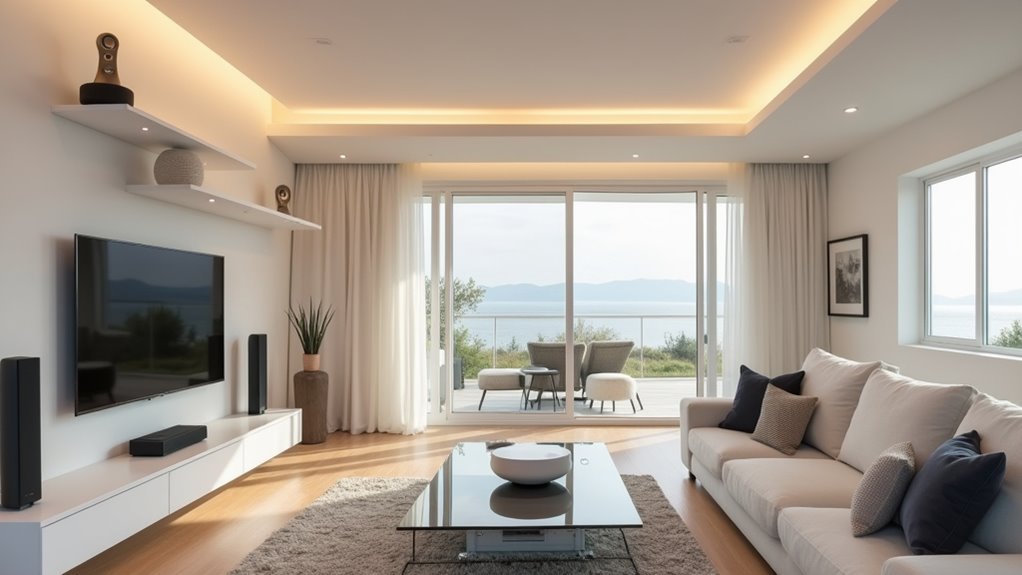
When setting up your whole-house audio system, the placement of your voice assistant devices directly impacts their performance and your overall experience. You’ll achieve ideal Voice Assistant functionality by positioning devices centrally in each room, where they can detect voice commands without obstructions.
While ceiling mounting maximizes microphone accessibility, it’s not always practical in existing homes, so consider elevated surfaces near your primary listening areas instead.
Your speaker options should integrate seamlessly with whole-house audio systems, ensuring consistent audio quality throughout your space. Position devices within WiFi or Bluetooth range of your sound sources for reliable connectivity.
Smart home integration works best when voice assistants can clearly hear commands from various room positions, so avoid placing them behind furniture or in corners where sound reflection might interfere with recognition accuracy.
Comparing Amazon Echo Dot and Google Home Mini for Whole-House Integration
When you’re choosing between Amazon Echo Dot and Google Home Mini for whole-house audio, you’ll find significant differences in their hardware capabilities and integration options.
The Echo Dot’s 3.5mm audio output gives you direct wired connections to existing audio systems, while the Google Home Mini relies solely on Bluetooth streaming.
These hardware distinctions directly impact how each device integrates with your WHA system and determines which voice assistant will work best for your multi-room setup.
Hardware Compatibility Analysis
While both voice assistants promise seamless smart home integration, the Amazon Echo Dot and Google Home Mini differ dramatically in their whole-house audio capabilities.
You’ll find the Echo Dot offers superior hardware compatibility through its 3.5mm audio output, enabling direct connections to your Whole House Audio system. This Amazon Echo Dot flexibility extends to ceiling mounts, wall installations, SIP connections, and centralized WHA controller links for extensive voice control integration.
Conversely, the Google Home Mini restricts you to Bluetooth-only connectivity with Input Panels, limiting audio output to its built-in speaker.
You’ll also benefit from the Echo Dot’s Auto Detect and Switch amplifier compatibility, which prioritizes voice responses over other sources—functionality unavailable with Google’s device.
Audio Output Options
These compatibility differences become most apparent when examining the distinct audio output configurations each device offers for whole-house integration.
The Echo Dot’s 3.5mm audio output gives you direct wired connection capabilities to your Whole House Audio system, while Google Home Mini lacks this essential feature.
You’ll find the Echo Dot’s audio output options far more versatile—you can mount it to ceilings with wired connections or pair it with Bluetooth receivers for seamless integration.
For larger installations, you can leverage audio baluns through existing Cat cables to transmit analog signals across long distances.
While Google Home Mini offers voice control through Bluetooth streaming to input panels, its responses stay confined to the built-in speaker, limiting overall system effectiveness compared to Echo Dot’s extensive integration possibilities.
WHA System Integration
The Echo Dot’s superior integration capabilities make it the clear choice for extensive WHA system implementation.
You’ll benefit from its 3.5mm audio output that connects directly to centralized controllers, enabling seamless voice commands throughout your home. Amazon Alexa devices can control your entire audio system from any room, creating a unified experience.
The Echo Dot’s ceiling or wall mounting options with Cat cable connections considerably improve microphone detection and audio performance in larger spaces.
You’ll also appreciate the Auto Detect and Switch feature that temporarily interrupts other sources when responding to voice commands.
In contrast, the Google Home Mini’s limitations become apparent—it lacks wired output options and restricts voice responses to its built-in speaker, preventing true WHA system integration despite Bluetooth connectivity.
Ceiling and Wall Mounting Solutions for Voice Assistants
Strategic placement transforms your voice assistant’s performance throughout your home.
Ceiling mounts offer ideal positioning for your Echo Dot by placing it centrally and reducing obstructions that interfere with microphone detection. You’ll achieve better voice command responsiveness across larger spaces when your voice assistants are mounted higher.
Elevate your Echo Dot with ceiling mounts for superior voice detection and optimal coverage across larger rooms.
These ceiling mounts connect via Cat cable, enabling seamless audio integration within your whole house audio system. If ceiling installation isn’t practical, you can use existing Cat cables with audio baluns for long-distance analog signal transmission.
Wall mounts provide another strategic option, ensuring your voice assistants stay within ideal listening ranges while maintaining your home’s aesthetic appeal.
Both mounting solutions help you maximize coverage and effectiveness throughout your entire audio system.
Connecting Voice Assistants to Existing Whole House Audio Systems
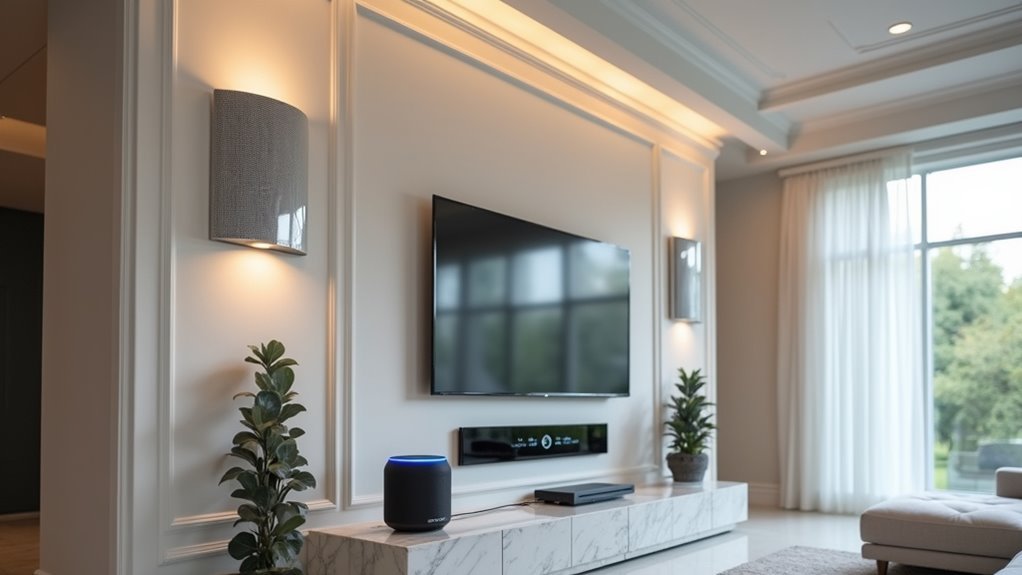
You’ll need to evaluate your existing whole house audio system’s inputs and outputs to determine the best connection method for your voice assistant.
Your options include direct wired connections through 3.5mm outputs or audio baluns over Cat cables, wireless solutions like Bluetooth integration, and hybrid approaches using amplifiers with Auto Detect and Switch capabilities.
The key is matching your voice assistant’s hardware capabilities with your WHA system’s available connection points.
Hardware Compatibility Options
Several hardware compatibility factors determine how effectively you’ll integrate voice assistants into your existing whole-house audio system.
The Echo Dot’s 3.5mm audio output provides direct wired connections to WHA controllers, while the Google Home Mini lacks this essential feature, limiting it to Bluetooth connectivity.
Consider these integration approaches:
- Direct Connection: Echo Dot connects via 3.5mm jack to amplifiers with Auto Detect and Switch functionality, allowing voice responses to interrupt current audio sources seamlessly.
- Bluetooth Pairing: Both devices can pair with Bluetooth speaker receivers, though proximity limitations affect reliability for whole-house coverage.
- Specialized Mounts: Alexa-compatible ceiling mounts and SIP integration options expand Echo Dot’s compatibility with professional audio systems beyond basic connections.
The Echo Dot consistently outperforms Google Home Mini for thorough whole-house audio integration.
Wired Connection Methods
When connecting voice assistants directly to your whole-house audio system, the Echo Dot’s 3.5mm audio output becomes your most reliable integration method.
These wired connection methods offer superior stability compared to wireless alternatives. You’ll want to install ceiling or wall mounts for ideal microphone detection while running Cat cables for power and audio transmission.
For long-distance installations, repurpose existing Cat cables with audio baluns to transmit analog signals throughout your home. This setup maintains audio quality over extended runs.
Consider integrating an amplifier with Auto Detect and Switch functionality, allowing your Echo Dot to temporarily interrupt other audio sources when responding to voice commands.
Unfortunately, Google Home Mini devices lack direct wired outputs, limiting your integration options to Bluetooth pairing only.
Wireless Integration Solutions
While wired connections provide the most stable performance, wireless integration solutions offer greater flexibility for connecting voice assistants to your existing whole-house audio system.
You can leverage Bluetooth capabilities to create seamless connections between your smart speaker and multi-room system without running additional cables.
Here are three effective wireless integration methods:
- Bluetooth Input Panel (BIP) Pairing – Connect your Google Home Mini directly to Lync systems’ BIP modules to stream music wirelessly throughout your home.
- Smart Speaker Distribution – Position multiple wireless speakers strategically to extend voice control coverage across different zones.
- Hybrid Wireless-Wired Setup – Combine wireless voice assistants with existing wired infrastructure, allowing you to stream music while maintaining centralized audio management through your current whole-house system.
Wiring Options Using Cat Cable and Audio Baluns
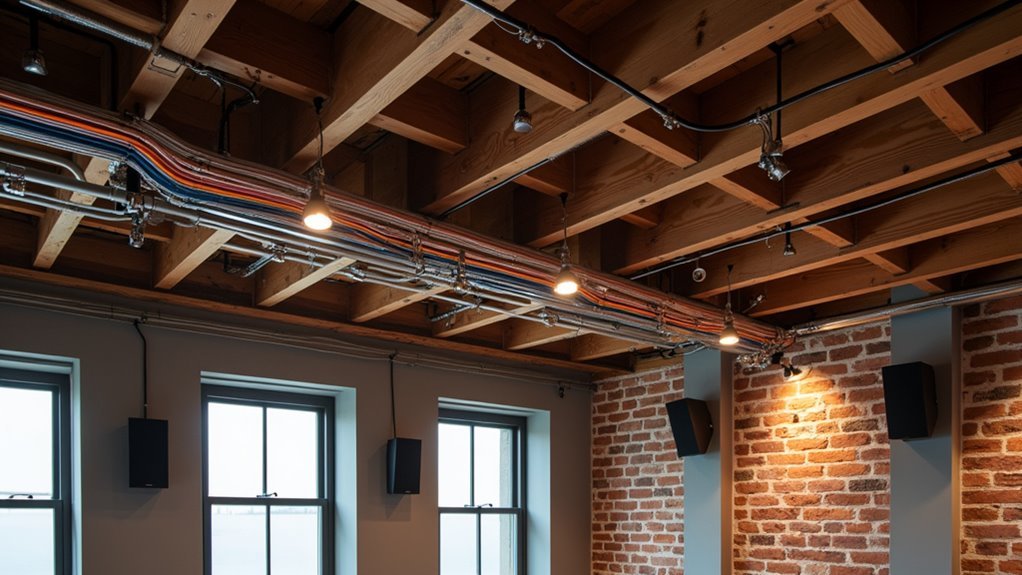
Although traditional audio wiring can become expensive and complex in larger homes, Cat cable paired with audio baluns offers an elegant solution that transforms your existing network infrastructure into a high-quality audio distribution system.
These wiring options let you repurpose Cat5 or Cat6 cables for analog signal transmission without compromising sound quality. Audio baluns convert balanced signals to unbalanced, enabling transmission distances up to 1000 feet throughout your whole-house audio system.
You’ll find this approach particularly effective for multi-zone audio setups, where multiple speakers connect across different rooms using your home’s existing network cabling.
Proper wiring prevents interference while maintaining audio integrity. This cost-effective solution works exceptionally well in homes that weren’t originally designed for distributed audio systems.
Bluetooth Pairing Strategies for Remote Audio Equipment
Cat cable solutions provide excellent wired connectivity, but wireless Bluetooth pairing opens up flexible options for connecting voice assistants and mobile devices to your whole-house audio system.
You’ll need to take into account distance limitations and strategic placement for ideal performance:
- Position devices within 30 feet of each other to maintain stable Bluetooth connections for reliable audio streaming throughout your home.
- Use Bluetooth Input Panels (BIP) to enable your Google Home Mini to wirelessly stream music to existing audio equipment while maintaining voice control functionality.
- Place Bluetooth receivers near your WHA equipment when pairing Amazon Echo Dots, though expect potentially less reliable connections over longer distances.
Remember that Bluetooth connections may limit some voice control features compared to wired setups.
Regularly monitor your Bluetooth settings and connection status to prevent audio playback interruptions.
Central Location Connection Methods and System Integration
You’ll achieve seamless voice control integration by configuring audio source inputs on your WHA system to accept signals from devices like Amazon Echo and Google Home.
These voice assistants can function as dedicated system sources, allowing you to issue commands and receive responses through your whole-house audio network.
Auto-detect switch integration takes this further by enabling voice assistants to temporarily override current audio sources when you need immediate responses to commands.
Audio Source Input Configuration
When configuring audio source inputs for your whole-house audio system, you’ll need to establish reliable connections between your voice assistants and the central distribution hub.
Proper audio source input configuration guarantees seamless wireless multi-room functionality while maintaining peak sound quality throughout your home.
Here’s how to configure different voice assistant connections:
- Alexa Device Integration – Connect your Echo Dot directly to the centralized controller using Cat cable mounting or integrate it into a Standard Input Panel within your Lync system for enhanced command distribution.
- Google Home Mini Setup – Pair directly with a Bluetooth Input Panel to enable streaming features, though voice responses remain on the Mini’s speaker.
- Auto Detection Implementation – Use amplifiers with Auto Detect and Switch functionality to allow voice responses to seamlessly interrupt other audio sources.
Auto-Detect Switch Integration
Although traditional audio switching can be cumbersome, Auto-Detect Switch (ADS) integration revolutionizes how your voice assistants connect to your whole-house audio system.
You’ll wire your Amazon Echo Dot’s audio output directly to the ADS amplifier at a central location, enabling seamless voice control throughout your home.
When you issue voice commands, the ADS amplifier automatically interrupts other audio sources to deliver immediate responses.
Models like the PLA-240ADS and DMA-1240ADS provide versatile output options that enhance your multi-room control capabilities.
The system intelligently switches between sources based on active commands, ensuring your voice assistant’s responses reach every connected room.
This centralized approach creates a cohesive whole-house audio experience where voice control seamlessly integrates with your existing entertainment setup.
Auto Detect and Switch Amplifier Configuration
Modern Auto Detect and Switch (ADS) amplifiers eliminate the frustration of manual audio source management by automatically identifying active inputs and seamlessly changing between them.
ADS amplifiers automatically detect active audio inputs and switch between sources instantly, eliminating the need for manual intervention in multi-room systems.
You’ll find that configuring these amplifiers properly transforms your multi-room audio system into an intelligent network that responds instantly to voice commands.
To configure your ADS amplifiers effectively, follow these essential steps:
- Connect to centralized WHA system – Wire your PLA-240ADS or DMA-1240ADS amplifiers directly to your whole-house audio hub for consistent distribution.
- Enable automatic source detection – Configure input sensitivity settings to recognize voice control capabilities from devices like Amazon Echo Dot.
- Test switching latency – Verify that audio changes occur within milliseconds to maintain seamless user experience.
This configuration guarantees your voice responses interrupt background music temporarily without manual intervention.
Voice Control Setup and Initial Device Configuration
Once your ADS amplifiers are properly configured, you’ll need to establish the foundation for voice control by selecting and setting up your primary voice assistant.
Choose between Google Nest or Amazon Alexa, then download the corresponding app for initial setup. Connect your voice assistant device to your home Wi-Fi network to guarantee seamless communication with your home audio components.
Next, link your assistant to compatible music services and speakers through the app interface. For your multi-room audio system, configure multiple compatible speakers using the app’s settings, allowing you to control audio in different rooms individually or collectively.
Regularly verify settings within the voice assistant’s app to maintain peak functionality and reliable performance throughout your entire whole-house audio installation.
Music Streaming Commands and Voice Assistant Compatibility
When selecting voice commands for your music streaming needs, you’ll find that Amazon Echo devices offer superior integration with whole-house audio systems compared to other options.
Echo devices connect directly to standard input panels, while Google Home Mini lacks wired audio output, limiting integration capabilities.
Both Alexa and Google Assistant support major music streaming services like Spotify, Apple Music, and Amazon Music. You can use simple commands such as “Alexa, play 91.1” or “Hey Google, play Spotify” for instant playback.
For ideal voice control performance, consider these setup recommendations:
- Connect Echo Dot to an amplifier with Auto Detect and Switch (ADS)
- Enable specific skills in assistant apps to expand streaming options
- Customize voice commands through device settings for enhanced functionality
Apple AirPlay and Siri Integration for Whole-House Audio
You’ll find that setting up AirPlay 2 creates a seamless foundation for voice-controlled whole-house audio throughout your home.
Once configured, you can use Siri commands like “Hey Siri, play jazz in the kitchen and living room” to instantly control playback across multiple rooms.
The system automatically handles multi-room syncing, ensuring your audio plays perfectly in time across all selected speakers without any noticeable delays.
AirPlay 2 Setup Process
Setting up AirPlay 2 for your whole-house audio system starts with connecting all compatible speakers to the same Wi-Fi network as your Apple devices. This guarantees seamless streaming throughout your home and enables reliable voice control functionality.
The setup process involves three key steps:
- Network Connection: Connect all AirPlay 2 compatible speakers to your home’s Wi-Fi network using each device’s setup instructions.
- Home App Configuration: Open the Apple Home app on your iPhone or iPad to group your speakers by room, allowing simultaneous playback or individual control.
- Voice Control Activation: Enable Siri on your devices to control music playback using commands like “Hey Siri, play music in the kitchen.”
Once configured, you’ll enjoy high-resolution audio streaming across your entire whole-house audio system.
Siri Voice Commands
Once your AirPlay 2 speakers are connected and configured in the Home app, Siri transforms your whole-house audio system into a voice-controlled entertainment hub. You can seamlessly stream different content to various smart speakers throughout your home using simple voice commands.
| Command Type | Example Voice Command |
|---|---|
| Play specific content | “Hey Siri, play jazz playlist in the living room” |
| Volume control | “Hey Siri, turn up the volume in the kitchen” |
| Multi-room streaming | “Hey Siri, play podcast everywhere” |
| Room-specific control | “Hey Siri, pause music in the bedroom” |
| Scene activation | “Hey Siri, start dinner music scene” |
With Siri integration, your multiroom audio system enables personalized listening experiences—relaxing music in one room while streaming podcasts elsewhere. You’ll control individual speakers or groups effortlessly through voice commands.
Multi-Room Audio Syncing
When you activate AirPlay 2’s multi-room syncing capabilities, your home transforms into a perfectly orchestrated audio environment where every speaker plays in perfect harmony.
Apple AirPlay 2 eliminates audio delays by synchronizing playback across all connected devices, ensuring seamless streaming music throughout your house.
You can configure your multi-room audio setup through three essential steps:
- Zone Creation – Use the Apple Home app to designate specific rooms and group compatible speakers together.
- Device Selection – Choose which HomePods, AirPlay-enabled speakers, or smart TVs participate in synchronized playback.
- Playback Control – Manage volume levels and audio sources individually or collectively across all zones.
With voice control integration, you’ll effortlessly command your entire audio network using simple Siri commands, creating an immersive listening experience tailored to your preferences.
Multi-Zone Control and Room-Specific Audio Management
The heart of any sophisticated whole-house audio system lies in its ability to deliver personalized listening experiences across multiple zones simultaneously. Multi-zone control empowers you to customize audio playback throughout your home, streaming different music in each room or syncing identical content across all speakers.
| Zone | Audio Source | Control Method |
|---|---|---|
| Living Room | Spotify | Voice Assistant |
| Kitchen | Apple Music | Sonos App |
| Bedroom | Podcast | Manual Control |
Advanced systems like the Sonos system integrate seamlessly with voice assistants, enabling hands-free adjustments through simple commands. You’ll access multiple streaming services while managing room-specific volume levels through intuitive app interfaces. Professional installation optimizes speaker placement for each zone’s unique acoustics, ensuring balanced sound distribution that transforms your entire home into a personalized audio environment.
Privacy Controls and Voice Assistant Security Settings
While voice-controlled audio systems offer unprecedented convenience, you’ll need to configure robust privacy settings to protect your personal data and maintain control over device interactions.
Smart speakers bring amazing convenience to your home, but proper privacy configuration is essential for protecting your personal information and conversations.
Your voice assistant requires careful security settings management to guarantee ideal protection.
Essential privacy controls for your whole-house audio system include:
- Physical mute buttons – Use the hardware mute functionality on devices like Google Nest Mini and Amazon Echo Dot to disable microphones when privacy is desired.
- Voice recording management – Access your assistant’s app to review past interactions, delete voice recordings, and control how your data improves services.
- Third-party limitations – Configure settings to restrict data sharing with external apps and services through your device’s privacy controls.
Regularly verify these data management settings to maintain thorough control over your voice assistant’s listening capabilities.
Troubleshooting Common Voice Control and Audio System Issues
Most voice control and audio system problems stem from simple configuration oversights or connectivity disruptions that you can resolve quickly with systematic troubleshooting.
Start by positioning your voice assistant in a central location to maximize microphone detection and eliminate obstructions that interfere with commands. Check compatibility between your voice assistant and audio system components, particularly when mixing different manufacturers or ecosystems.
For Bluetooth connections, stay within 30 feet to maintain stable pairing and prevent streaming disruptions. Use your voice control system’s app to enable necessary skills and permissions, which improves command recognition functionality.
When experiencing audio response issues, verify settings in both your voice assistant app and audio system app, making adjustments to guarantee seamless integration between all connected devices.
Frequently Asked Questions
How to Set up a Whole House Speaker System?
Choose compatible speakers like Amazon Echo or Sonos, plan your layout for ideal sound distribution, use dedicated apps to configure multi-room settings, guarantee stable Wi-Fi throughout your home, and consider professional installation.
How Can I Play Music Throughout My House?
You can install a whole house audio system using smart speakers like Sonos or Amazon Echo connected to Wi-Fi, then control music playback with voice commands for seamless streaming throughout every room.
How Much Does a Whole House Audio System Cost?
You’ll spend $1,500 to $10,000+ for a whole-house audio system, depending on complexity and zones covered. Installation adds $1,000-$5,000 more. Don’t forget ongoing streaming subscriptions and maintenance costs.
How Do I Set up Surround Sound in My House?
You’ll need five speakers plus a subwoofer connected to an AV receiver. Position front speakers at 22-30 degrees from your listening spot, place surrounds slightly behind you, then run audio calibration for ideal sound.

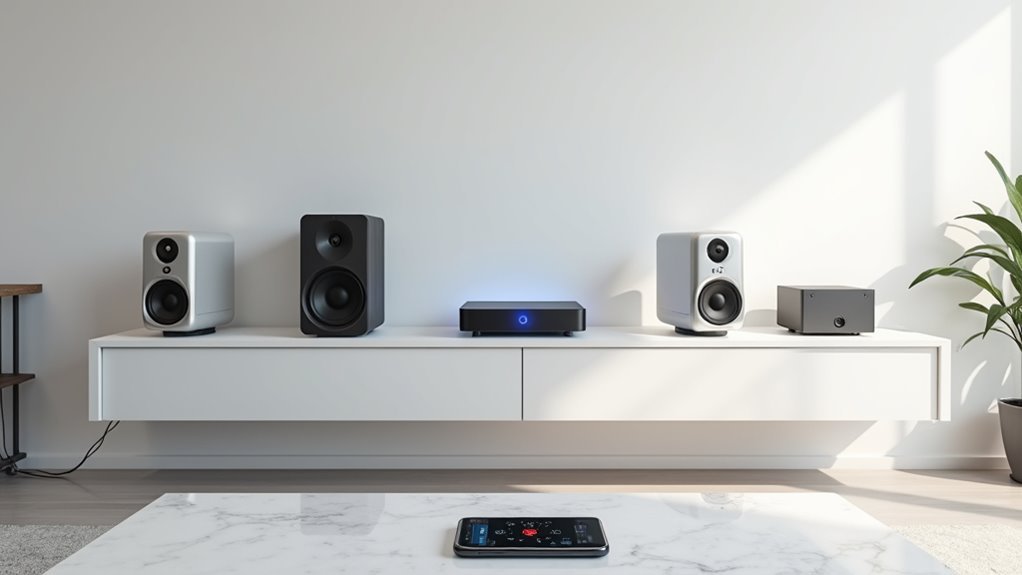
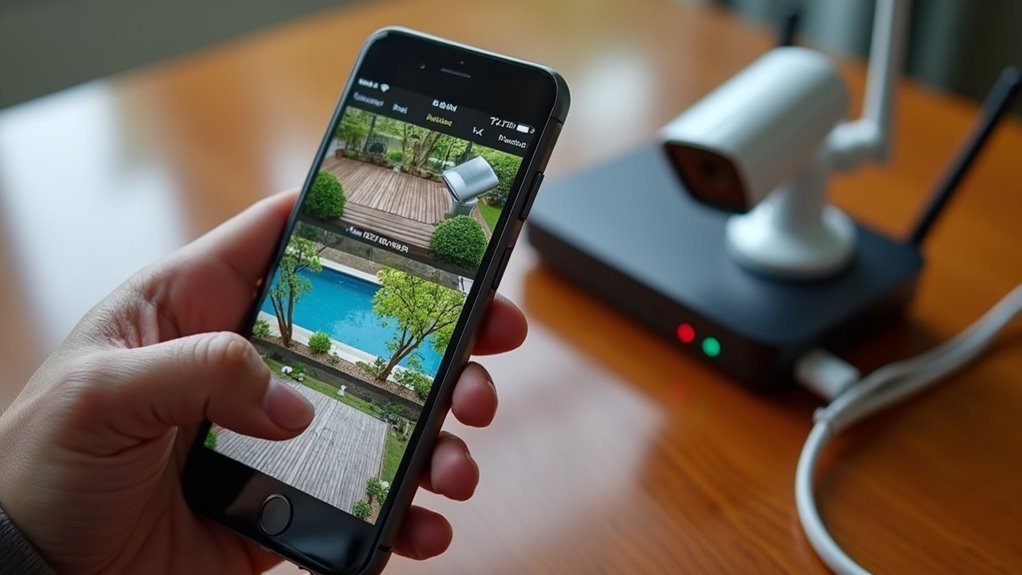
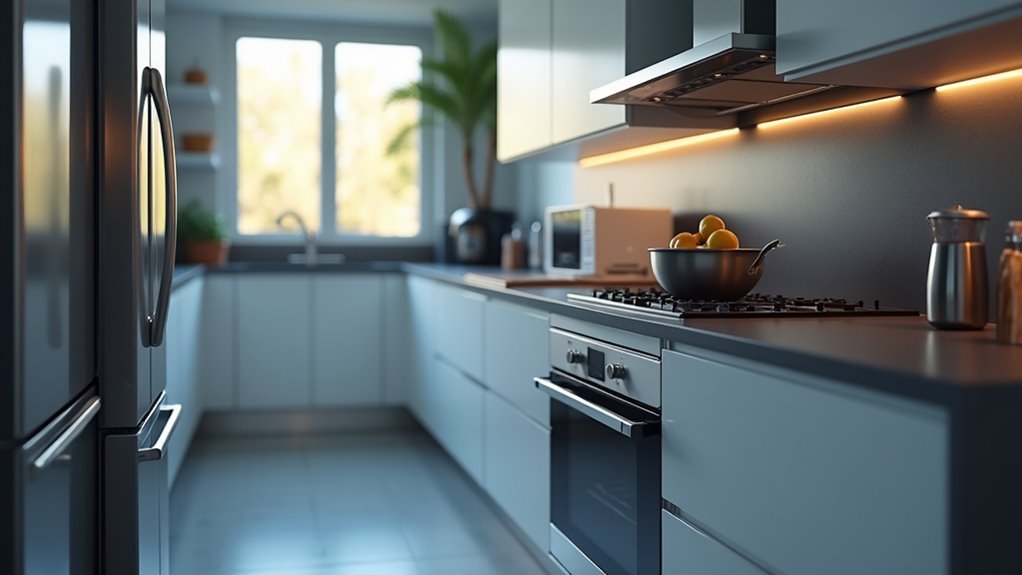
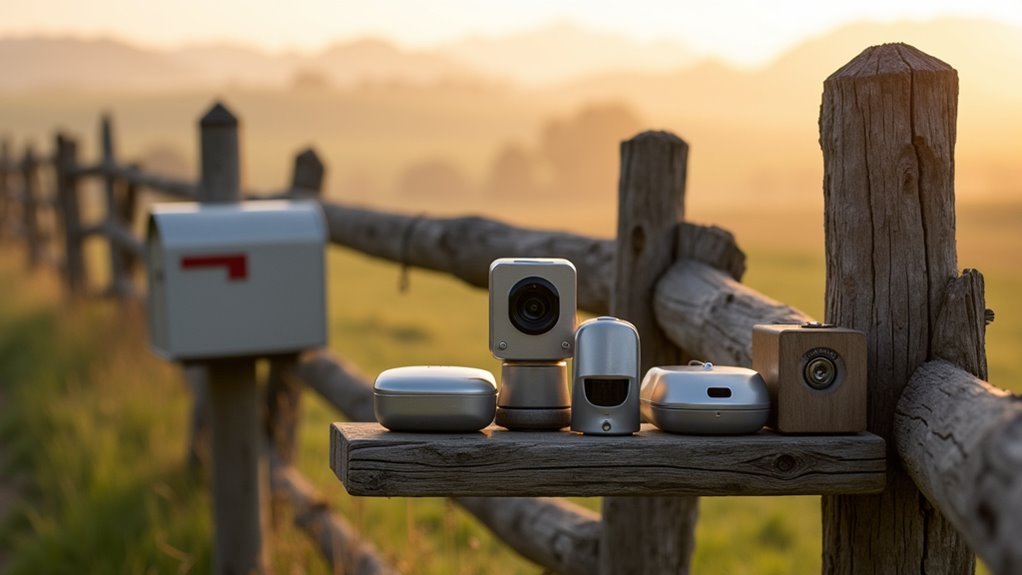
Leave a Reply